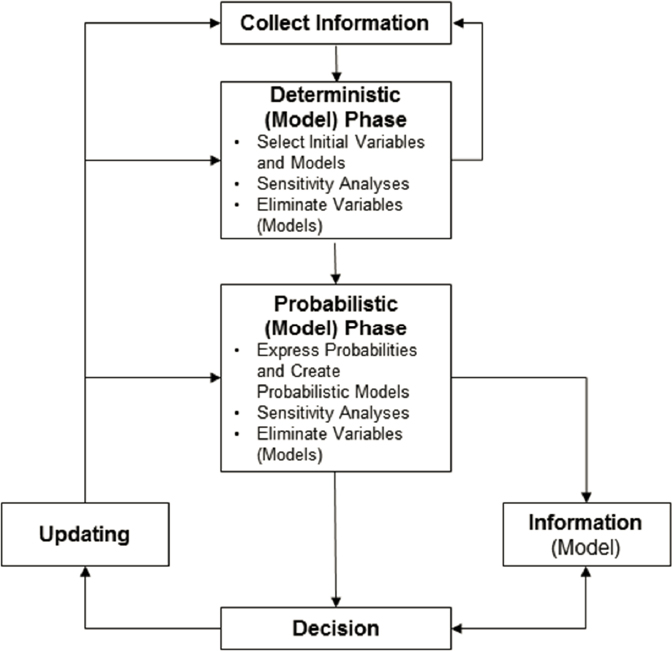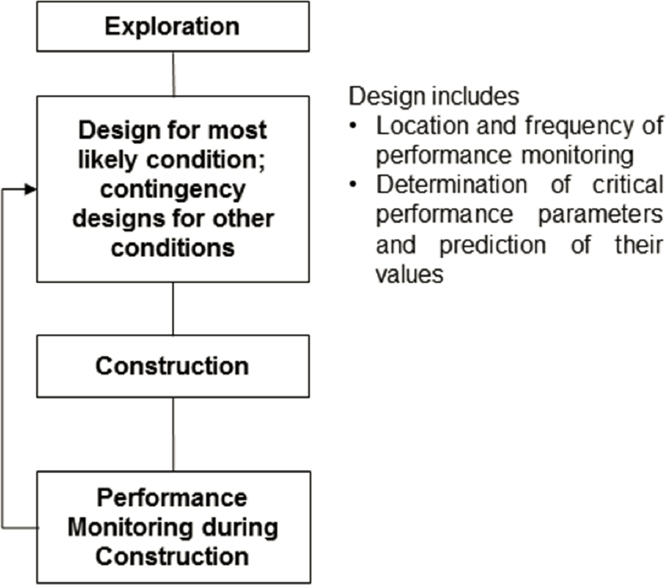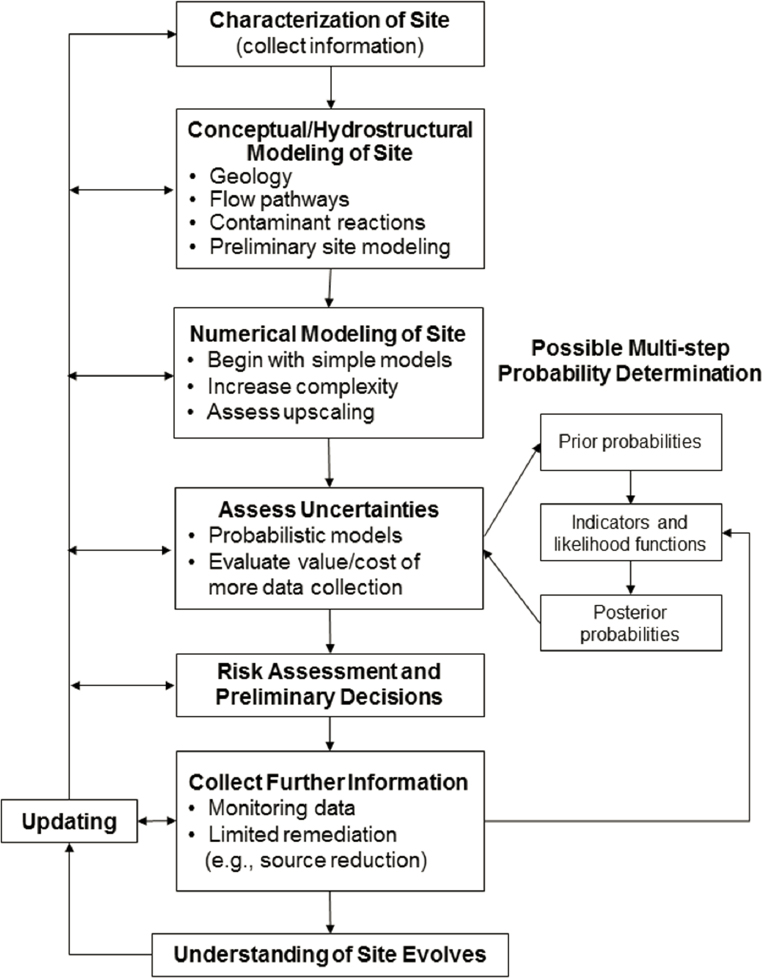7
Decision Making
As discussed in previous chapters, the characterization, modeling, monitoring, and remediation of the fractured rock environment is challenging because of (1) the complexities of the mechanical, chemical, and biological environments of fractured rock, and (2) the spatial and temporal variability of the processes that affect fluid flow, contaminant migration, and contaminant storage and degradation. The quantity and quality of information available for fractured rock sites varies, making the development of a flexible but robust engineering decision framework a challenge.
A decision-making framework for engineering or operating engineered facilities in fractured rock sites needs to be adaptable to a wide range of conditions and the most critical engineering questions. Historically, engineering goals such as remediation have been viewed as endpoints or terminal processes in linear activities. However, earlier chapters in this report demonstrate that engineering goals and solutions can be refined and made more effective if informed regularly by new characterization, modeling, and monitoring data. This implies that a shift from a linear to a cyclic decision-making framework will result in more effective and efficient engineering.
The importance of understanding uncertainties in characterization, modeling, monitoring, and remediation of fractured rock is stressed throughout this report. Much decision making related to engineering a site—whether for future waste disposal, remediation of existing contamination, or performance monitoring of any manner of infrastructure—is based on some form site conceptual model and needs to include consideration of uncertainty. Indeed, the decision-making framework should be designed to consider and, if possible, reduce uncertainties to attain effective and efficient engineering solutions. A classification structure for uncertainties is summarized in Box 7.1.
The consistent and systematic consideration of uncertainties is critical in fractured rock engineering. Decision making under uncertainty has a long history in business management (Pratt et al., 1965; Raiffa, 1968; Staël von Holstein, 1974). The underlying procedure is schematically captured in Figure 7.1. Each phase of the cycle outlined in this figure is directly mappable to the engineering solutions described earlier in this report. By the scheme depicted in Figure 7.1, information collection occurs early and throughout the process (i.e., characterization), but more information may be gathered as warranted (i.e., more characterization and monitoring). Deterministic and probabilistic modeling can be applied to both hydrostructural (conceptual) model development and numerical modeling (simulation). The process of decision making has only been discussed implicitly and without explanation earlier in this report. This chapter first describes ideas and concepts for decision making in the related fields of rock mechanics and geotechnical engineering. It is then shown how these concepts could be applied to the characterization, modeling, monitoring, and remediation of fractured rock. The concept of updating is also discussed. Updating describes the various processes that result in change, such as the acquisition of additional information or the application of remediation strategies.
DECISION MAKING AND UPDATING IN THE CONTEXT OF THIS REPORT
Models depict outcomes such as the prediction that a particular concentration of a contaminant reaches some level in the rock mass. These outcomes are rarely deterministically expressed in
fractured rock settings. Outcomes from deterministic models can be compared to regulatory limits, model outcomes given different input parameters, or outcomes of another model. In almost all cases, however, a probabilistic model can provide valuable insights regarding the relationship between uncertainties and various model predictions. Simple or complex decisions can then be made, for example, on the choice of a particular model, the need for more model input parameters, or the choice of specific remediation strategies. Making decisions based on model outcome underlies even the most complex process.

SOURCES: Modified from Einstein, 2002, after Staël von Holstein, 1974.
Updating
Action logically follows a decision. In the context of decision making under uncertainty, this action is called updating (see Figure 7.1). Formal procedures, mostly based on Bayes’ updating (Ang and Tang, 1975), exist and have been widely applied (e.g., Einstein, 1988). Collecting additional information changes (updates) model input parameters and may result in different decisions being made. Choosing a different model or modifying a model based on new information are both forms of updating the models. These may result in changed model output and altered decisions. Because remediation activities change environmental conditions, they are also a form of updating. Information collection itself is also subject to uncertainties and so decisions are made regarding the need to collect information. Literature on how to apply the information model, and the concepts and application of value of information (specifically, the value of sample information and the value of prefect information) in the context of geotechnical and geoenvironmental engineering exists (see, e.g., Einstein et al., 1978; Cardiff et al., 2010; Neuman et al., 2012; Sousa et al., 2014).
The information collection and the models that are part of the decision cycle have been extensively covered earlier in this report. The application of the observational method to the decision process is discussed below.
OBSERVATIONAL METHOD IN GEOTECHNICAL ENGINEERING
The observational method in geotechnical engineering is a process that involves investigation, characterization, design, construction, and management based on the most probable conditions expected at a site rather than the worst-case scenario. This section summarizes the observational method in geotechnical engineering for those unfamiliar with it. Because it is recognized that much is learned about a geotechnical project during the project cycle, pre-determined modifications to design, construction, or operation can be made at any time based on review of observations. The observational method is intended to minimize project costs—without sacrificing project safety—by allowing for flexibility in decision making based on updated information.
The term observational method appears to have been proposed by Terzaghi (1961), but he refers to a very early application at the beginning of the 20th century. Philosophically, one can relate the observational approach to what was proposed by the geologist T. C. Chamberlin (1897), namely, the multiple working hypotheses. Chamberlin dealt with the uncertainty in geologic interpretations, similar to what the geotechnical observational method attempts to do. This method, which follows the principle shown in Figure 7.2, is well established, although not always used. Figures 7.1 and 7.2 have strong similarities, in particular the feedback cycle in Figure 7.2, which corresponds to the updating in Figure 7.1.
The essence of Figure 7.2 is that a number of design options are developed, each of which includes an associated performance prediction. This predicted performance is then compared to the observed performance, and a decision is made to either maintain the current design or use another design (i.e., update the decision). All of this reflects the fact that geologic and geotechnical conditions are uncertain and that there is a need to react flexibly to new information. This decision-making method is used in other applications, such as the recommended approach for design of carbon dioxide injection wells for the purpose of sequestering carbon. In such applications, injector wells are placed, observed, and operated prior to collection of performance data (Cameron and Durlofsky, 2014). Model predictions are then updated, and well settings may be altered in response to performance data collected. An iterative approach that includes quantifying uncertainties is also
suggested for the decision methodology for both mined repositories (Meacham, 2011) and deep borehole disposal of nuclear waste (Arnold et al., 2012).
Expanding beyond Terzaghi’s description of the method, Peck (1969) proposed a detailed stepwise approach (see Box 7.2). One consequence of the observational method, however, is that it can be difficult to bid and award a contract in a fixed cost (time) framework. This is because the approach recognizes the appropriateness of different designs and outcomes depending on observed site conditions. Possible ways to formulate contracts for an adaptable approach have been discussed (e.g., Stasiewicz, 1981; Patel et al., 2007), but the fixed cost (time) environment traditional in public works contracts makes the observational approach difficult to apply. The observational method is often not employed fully or is ignored because of fixed regulatory requirements. An application of the observational method in fractured rock that could inform infrastructure management and site remediation approaches is in the context of the new Austrian tunneling method (NATM). Examples of the application of the NATM are Tentschert et al. (2003) and Golser and Schubert (2003). Other recent examples of application of the observational method in the fractured rock environment include Bäckblom and Öhberg (2002), Hernqvist et al. (2012), and Olofsson et al. (2014). The adaptability and flexibility of the observational approach is not only well suited for geotechnical engineering but is consistent with approaches to fractured rock site remediation and management as discussed in Chapter 6, and for geoenvironmental problems more generally.

EVOLVING THE OBSERVATIONAL METHOD TO GEOENVIRONMENTAL ENGINEERING
Geoenvironmental engineering decisions are often driven by compliance-based requirements. For example, decision processes employed routinely by many engineers and scientists for cleanup of contaminated sites in the United States are heavily influenced by requirements of the U.S. Environmental Protection Agency (EPA) under the Comprehensive Environmental Response, Compensation, and Liability Act, commonly referred to as Superfund (EPA, 1999b). The highly linear decision process is described in EPA’s guidelines and involves
- Remedial investigations and feasibility studies (site characterization, treatability studies, evaluation of alternatives),
- A remedy selection process (identification of preferred remediation scheme),
- Development of a proposed plan,
- Opportunity for public comment,
- Remedy selection,
- Announcement of a record of decision,
- Remedy implementation, and
- Long-term maintenance.
This linear decision-making process provides little opportunity to learn from new information (i.e., update through feedback loops) and iteration of any step once a decision is made and recorded as a public document (typically by a judge at the end of a lengthy, sometimes contentious, and expensive adjudication process). This process can be effective for relatively simple sites that can be well characterized with acceptable levels of uncertainty (e.g., through pump tests), and when conceptual site models can be analyzed readily with available numerical techniques to predict the fate and transport of contaminants. A linear process facilitates quick deployment of remediation
designs, but new information seldom results in radical modification of conceptual and numerical models or remediation plans.
Most fractured rock sites, however, require greater levels of characterization and are burdened with higher levels of uncertainty. Under these circumstances, engineering solutions rarely are arrived at using the linear processes favored under the current regulatory environment. Conceptual and numerical models for fractured rock sites require more variables to be quantified, more assumptions to be made, and contain greater uncertainty in both quantification and qualification. The best models tend to be those that are modified as new information is gathered during characterization, monitoring, and remediation—methods far more consistent with the observational approach. This approach to model development can lead to better understanding of a site and the most effective site management approaches. However, the current regulatory environment does not accommodate these approaches.
Application of the observational method is relevant particularly when performance depends on complex coupled processes at a variety of temporal and spatial scales, for example, the isolation of nuclear waste in fractured rock settings. As noted by Yow and Hunt (2002, pp. 145–146):
we measure most rock properties and processes in experiments and tests that are orders of magnitude smaller and of much shorter duration than engineering projects. Together with the complications of site heterogeneity and parameter variability, this makes it difficult to predict and extrapolate the effects of coupled processes to larger scales and over time.
The observational method is embedded in adaptive site management (NRC, 2003) and in long-term management when traditional site remediation technologies prove ineffective (NRC, 2013b). In all cases, the decision-making process needs to be applied throughout the lifecycle of the engineered facility, which may extend over millennia, and be used to continuously reassess engineering goals, available and needed information and associated uncertainties, and appropriateness of engineering decisions. If new information cannot reduce uncertainties to acceptable levels, or if monitoring indicates that implemented decisions are not producing predicted results, then it is necessary to question the appropriateness of the original engineering goals.
The decision process outlined in Figures 7.1 and 7.2 is reframed in Figure 7.3 to reflect the vocabulary and processes central to this report, and Box 7.3 provides a theoretical application of the observational method. It is intended to guide rather than prescribe decision making under almost any geoenvironmental engineering circumstance and for most temporal and spatial scales.
Effective geoenvironmental engineering in fractured rocks requires iterative and adaptive processes to minimize physical risks to health and environment. The observational method works around the inescapable fact that needed information about a fractured rock site generally is gained only once the project advances. A proper decision-making approach includes multiple decision points at which available information is assessed, decisions can be improved based on an increasingly accurate site model and more reliable information, and project goals are met, sustained, and re-evaluated when necessary. Decision making within an observational approach is uniquely adapted to address these needs.








